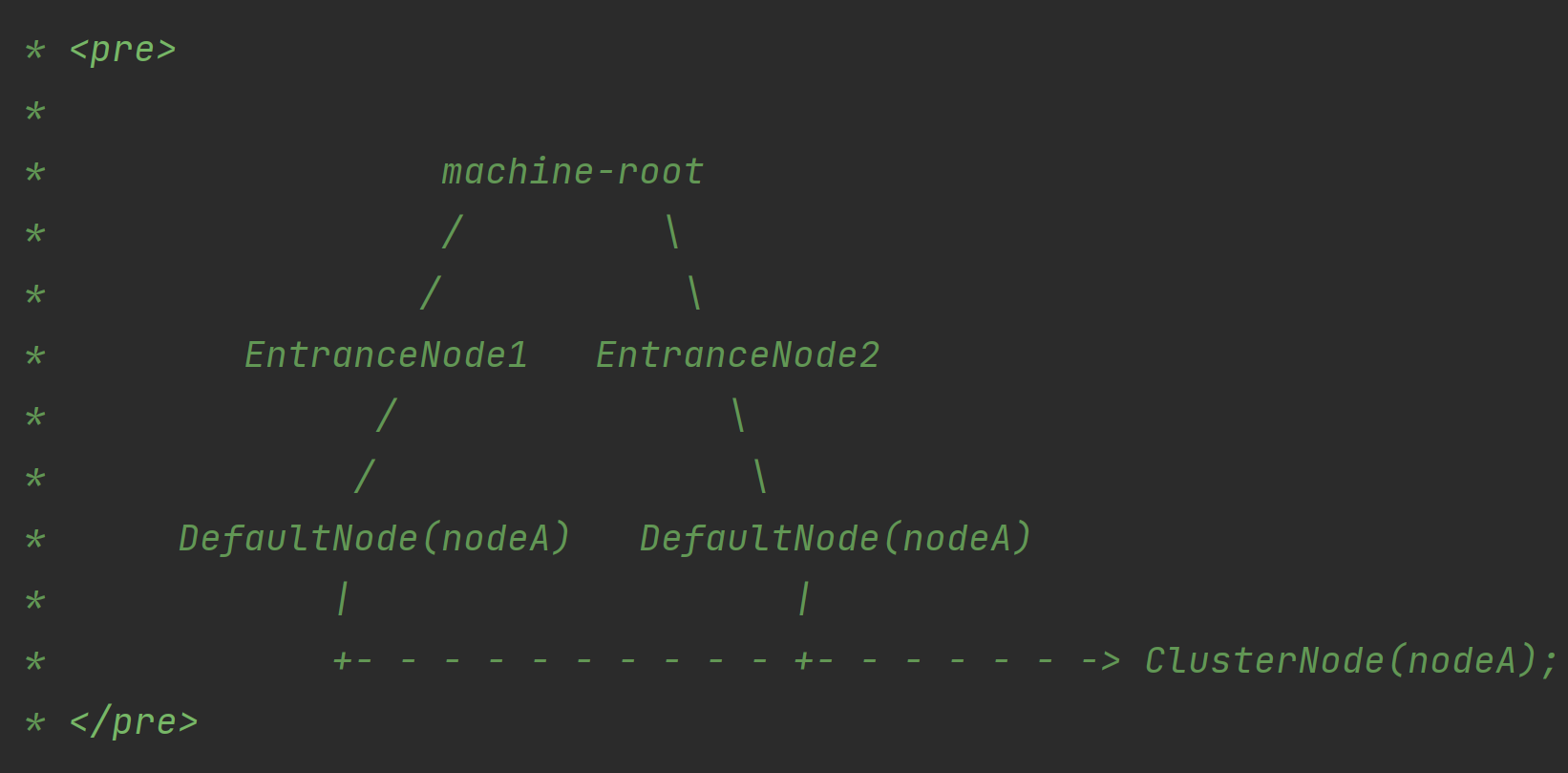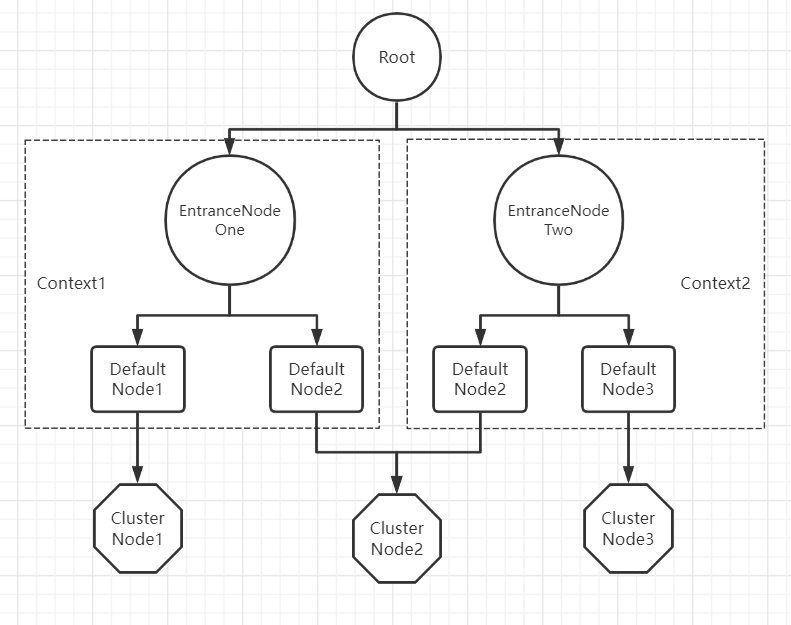# Sentinel源码解析-SlotChain入口解析
# 默认Chain解析
我们从这里继续分析,这个位置的chain.entry方法,但是此时这个chain是谁?
//CtSph中
try {
// 针对资源操作
chain.entry(context, resourceWrapper, null, count, prioritized, args);
} catch (BlockException e1) {
e.exit(count, args);
throw e1;
} catch (Throwable e1) {
// This should not happen, unless there are errors existing in Sentinel internal.
RecordLog.info("Sentinel unexpected exception", e1);
}
2
3
4
5
6
7
8
9
10
11
那么这个位置开始,我们就要分析一下如下代码
官方定义:Sentinel 将 ProcessorSlot作为 SPI 接口进行扩展(1.7.2 版本以前 SlotChainBuilder作为 SPI),使得 Slot Chain 具备了扩展的能力。您可以自行加入自定义的 slot 并编排 slot 间的顺序,从而可以给 Sentinel 添加自定义的功能。
lookProcessChain()用于构建一个责任链。Sentinel的处理核心都在这个责任链中,链中每一个节点是一个Slot实例,这个链通过BlockException异常来告知调用入口最终的执行情况
// 获取chain链
ProcessorSlot<Object> chain = lookProcessChain(resourceWrapper);
//-------------------具体看lookProcessChain方法---------------------
ProcessorSlot<Object> lookProcessChain(ResourceWrapper resourceWrapper) {
// 先从chainMap获取,若是存在,则直接返回
ProcessorSlotChain chain = chainMap.get(resourceWrapper);
if (chain == null) {
synchronized (LOCK) {
chain = chainMap.get(resourceWrapper);
if (chain == null) {
// Entry size limit.
if (chainMap.size() >= Constants.MAX_SLOT_CHAIN_SIZE) {
return null;
}
// 通过SlotChainProvider创建一个slot链
chain = SlotChainProvider.newSlotChain();
Map<ResourceWrapper, ProcessorSlotChain> newMap = new HashMap<ResourceWrapper, ProcessorSlotChain>(
chainMap.size() + 1);
newMap.putAll(chainMap);
// 添加到Map缓存中
newMap.put(resourceWrapper, chain);
chainMap = newMap;
}
}
}
return chain;
}
2
3
4
5
6
7
8
9
10
11
12
13
14
15
16
17
18
19
20
21
22
23
24
25
26
27
这个位置我们要具体分析SlotChainProvider这个类型,它的主要作用就是通过已解析的槽链构建器,创建槽链的提供者
从这里我们可以看出SlotChainBuilder及ProcessorSlot 使用Java SPI技术实现可配置化,即在/META-INF/services/接口全限命名 的文件中配置实现类,然后由ServiceLoader实现加载,这种技术在SpringBoot中都有使用。不作讲解。
package com.alibaba.csp.sentinel.slotchain;
import com.alibaba.csp.sentinel.log.RecordLog;
import com.alibaba.csp.sentinel.slots.DefaultSlotChainBuilder;
import com.alibaba.csp.sentinel.spi.SpiLoader;
/**
* A provider for creating slot chains via resolved slot chain builder SPI.
*
* @author Eric Zhao
* @since 0.2.0
*/
public final class SlotChainProvider {
private static volatile SlotChainBuilder slotChainBuilder = null;
/**
* The load and pick process is not thread-safe, but it's okay since the method should be only invoked
* via {@code lookProcessChain} in {@link com.alibaba.csp.sentinel.CtSph} under lock.
*
* @return new created slot chain
*/
public static ProcessorSlotChain newSlotChain() {
if (slotChainBuilder != null) {
return slotChainBuilder.build();
}
// 读取配置文件在/META-INF/services/接口全限定命名的文件中配置实现类.
slotChainBuilder = SpiLoader.of(SlotChainBuilder.class).loadFirstInstanceOrDefault();
if (slotChainBuilder == null) {
// Should not go through here.
RecordLog.warn("[SlotChainProvider] Wrong state when resolving slot chain builder, using default");
//使用默认的DefaultSlotChainBuilder来构建ProcessorSlotChain
slotChainBuilder = new DefaultSlotChainBuilder();
} else {
RecordLog.info("[SlotChainProvider] Global slot chain builder resolved: {}",
slotChainBuilder.getClass().getCanonicalName());
}
//使用DefaultSlotChainBuilder构建
return slotChainBuilder.build();
}
private SlotChainProvider() {}
}
2
3
4
5
6
7
8
9
10
11
12
13
14
15
16
17
18
19
20
21
22
23
24
25
26
27
28
29
30
31
32
33
34
35
36
37
38
39
40
41
42
43
44
45
到这里我们就清楚的知道了其实现在使用的是使用DefaultSlotChainBuilder.build()来创建的,以下是源码
在这个其中,做了几件事:
1. 创建DefaultProcessorSlotChain
2. 读取/META-INF/services/中的配置文件
3. 强制转型为AbstractLinkedProcessorSlot(所有插槽的抽象父类)
@Spi(isDefault = true)
public class DefaultSlotChainBuilder implements SlotChainBuilder {
@Override
public ProcessorSlotChain build() {
// 创建DefaultProcessorSlotChain
ProcessorSlotChain chain = new DefaultProcessorSlotChain();
// 读取配置文件在/META-INF/services/接口全限定命名的文件
List<ProcessorSlot> sortedSlotList = SpiLoader.of(ProcessorSlot.class).loadInstanceListSorted();
for (ProcessorSlot slot : sortedSlotList) {
if (!(slot instanceof AbstractLinkedProcessorSlot)) {
RecordLog.warn("The ProcessorSlot(" + slot.getClass().getCanonicalName() + ") is not an instance of AbstractLinkedProcessorSlot, can't be added into ProcessorSlotChain");
continue;
}
chain.addLast((AbstractLinkedProcessorSlot<?>) slot);
}
return chain;
}
}
2
3
4
5
6
7
8
9
10
11
12
13
14
15
16
17
18
19
20
21
具体读取的内容如下:
# Sentinel default ProcessorSlots
com.alibaba.csp.sentinel.slots.nodeselector.NodeSelectorSlot
com.alibaba.csp.sentinel.slots.clusterbuilder.ClusterBuilderSlot
com.alibaba.csp.sentinel.slots.logger.LogSlot
com.alibaba.csp.sentinel.slots.statistic.StatisticSlot
com.alibaba.csp.sentinel.slots.block.authority.AuthoritySlot
com.alibaba.csp.sentinel.slots.system.SystemSlot
com.alibaba.csp.sentinel.slots.block.flow.FlowSlot
com.alibaba.csp.sentinel.slots.block.degrade.DegradeSlot
2
3
4
5
6
7
8
9
这些就是Sentinel提供的默认功能插槽
# NodeSelectorSlot解析
分析到这里我们就可以回到CtSph中,查看entry方法这个时候我们就知道了实际上调用entry方法的是DefaultProcessorSlotChain
try {
// 针对资源操作
chain.entry(context, resourceWrapper, null, count, prioritized, args);
} catch (BlockException e1) {
e.exit(count, args);
throw e1;
} catch (Throwable e1) {
// This should not happen, unless there are errors existing in Sentinel internal.
RecordLog.info("Sentinel unexpected exception", e1);
}
2
3
4
5
6
7
8
9
10
那我们向下跟踪
@Override
public void entry(Context context, ResourceWrapper resourceWrapper, Object t, int count, boolean prioritized, Object... args)
throws Throwable {
// 转到下一个节点
first.transformEntry(context, resourceWrapper, t, count, prioritized, args);
}
2
3
4
5
6
这个位置是转入到下一个节点,那么下一个节点明显就是NodeSelectorSlot,那我们来看具体操作
void transformEntry(Context context, ResourceWrapper resourceWrapper, Object o, int count, boolean prioritized, Object... args)
throws Throwable {
T t = (T)o;
//NodeSelectorSlot
entry(context, resourceWrapper, t, count, prioritized, args);
}
2
3
4
5
6
NodeSelectorSlot具体内容官网有给出解释:
这个 slot 主要负责收集资源的路径,并将这些资源的调用路径,以树状结构存储起来,用于根据调用路径来限流降级。
DefaultNode用于统计一个resource在当前Context中的流量数据,所以再结合NodeSelectorSlot,最终得出结论:处理不同的Context name,同一个Resource name的情况
@Override
public void entry(Context context, ResourceWrapper resourceWrapper, Object obj, int count, boolean prioritized, Object... args)
throws Throwable {
// 从缓存中获取,创建DefaultNode
DefaultNode node = map.get(context.getName());
// 双重判断,如果判断为空
if (node == null) {
synchronized (this) {
node = map.get(context.getName());
if (node == null) {
// 创建一个DefaultNode并且放入到缓存中
node = new DefaultNode(resourceWrapper, null);
HashMap<String, DefaultNode> cacheMap = new HashMap<String, DefaultNode>(map.size());
cacheMap.putAll(map);
cacheMap.put(context.getName(), node);
map = cacheMap;
// Build invocation tree
// 将新建的Node添加到调用树中
((DefaultNode) context.getLastNode()).addChild(node);
}
}
}
context.setCurNode(node);
// 触发下一个节点
fireEntry(context, resourceWrapper, node, count, prioritized, args);
}
2
3
4
5
6
7
8
9
10
11
12
13
14
15
16
17
18
19
20
21
22
23
24
25
26
27
28
29



